An extended version of this post also appeared at Ms.
I’ve been taking photographs of breast-cancer-research-and-prevention-branded products for a few months now. I was first driven to do so when I saw this at the Million Aire (private plane terminal) at the Burbank airport:

That’s right. You are looking at pink chocolate chips cooked into cookies to signify a commitment to reducing breast cancer-related morbidity and mortality.
Anti-breast cancer messages are, I think inarguably, the most widely product-linked disease-related message ever. I am constantly shocked by how many products have a breast cancer version. Here are some pictures I’ve taken over the last few months.
Cream cheese:
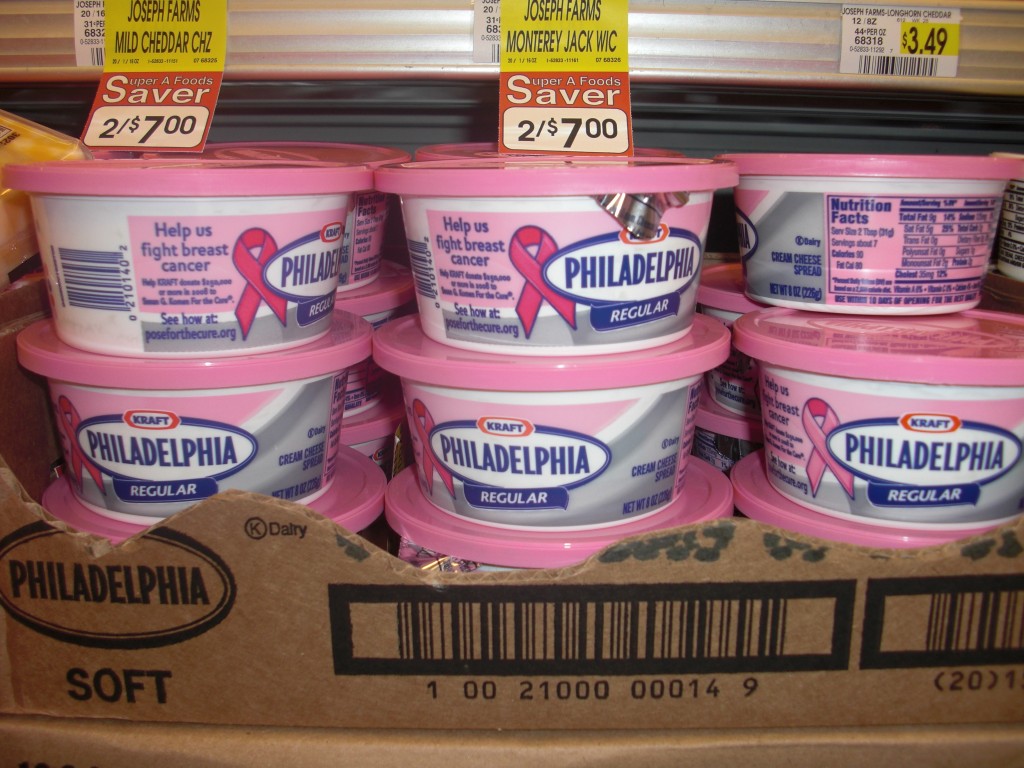
Padlock:

Cat food:

Gum:
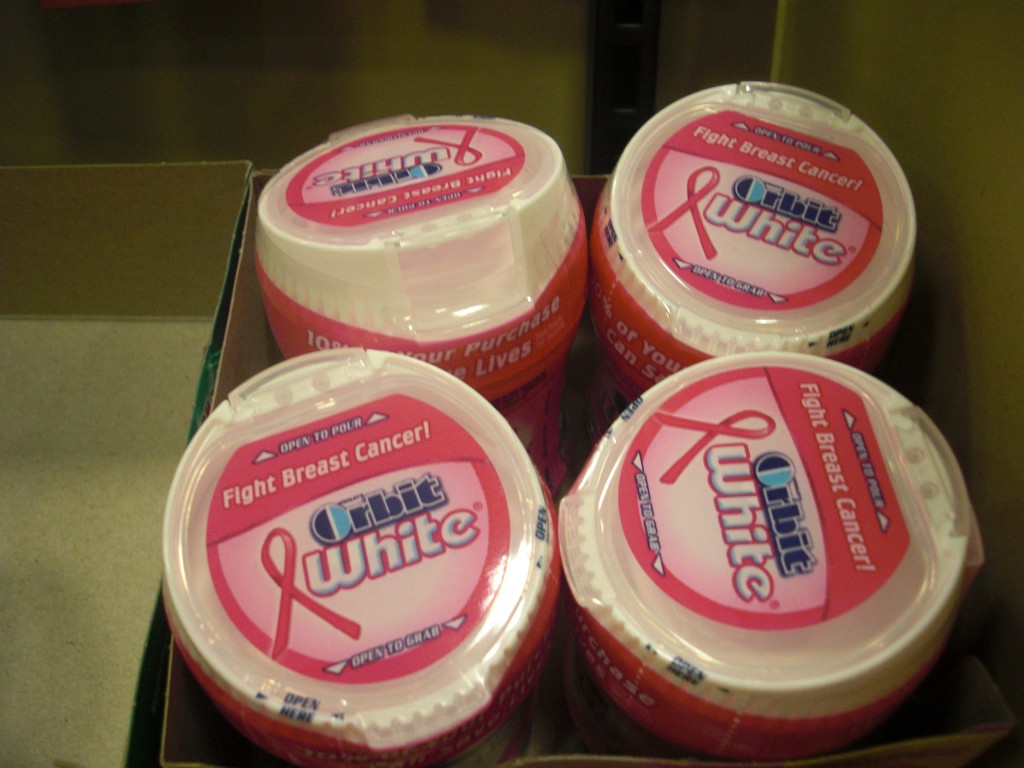
Golf balls and tees:
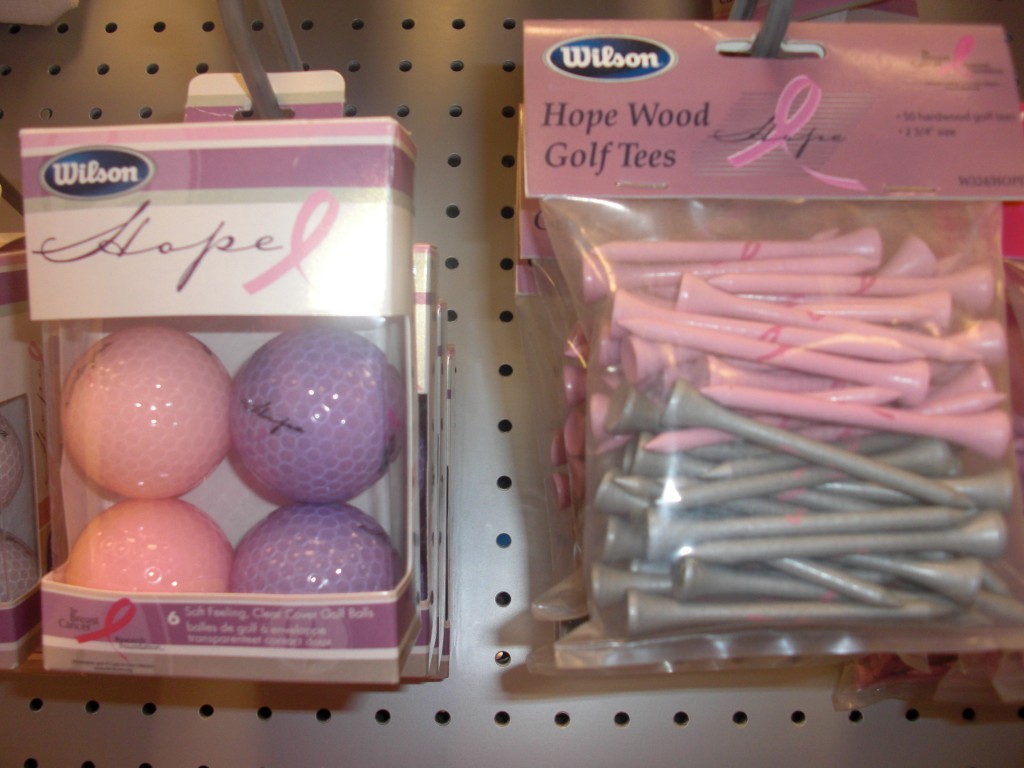
Pots and pans:
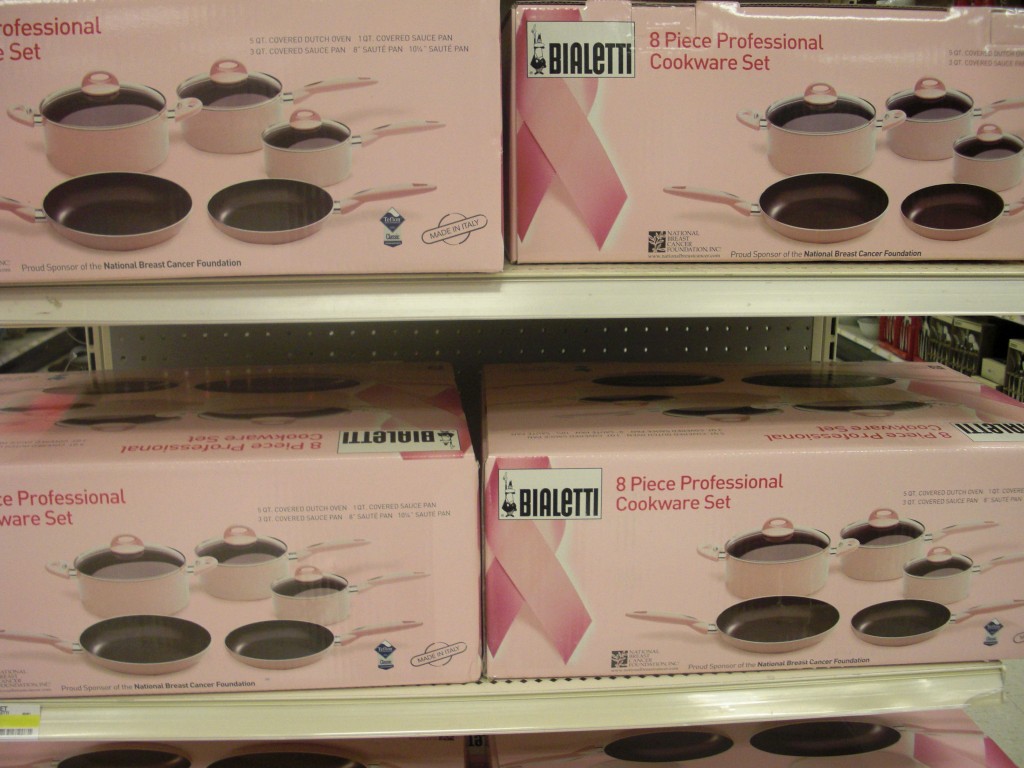
Steve W. sent in this picture of a pink “ladies night out” breast cancer-themed limo (note the pink ribbon hanging from the rear view mirror):

NEW (May ’10)! Renée Y. sent along this photo of breast cancer-awareness-themed grape tomatoes. I repeat: grape tomatoes.
We’ve discussed the commodification of activism extensively (see here, here, here, here, and here) and so I’m going to skip this point. Instead, I’d like the ask the following:
What does it mean when awareness of and funding for disease is subject to marketing? Is this really the most efficient or rational way to set health care priorities? I did a bit of research.
According to the CDC (2005 seems to be the latest available data), cancer is not the leading cause of death. Heart disease is the leading cause of death. Granted, cancer is a close second. In 2005, 652,091 people died of heart disease and 559,312 died of cancer. But not breast cancer, all cancers. In 2005, 49,491 people died of breast cancer. More than 10 times as many people died of heart disease.
And, if you want to prioritize cancers, more people are diagnosed with prostate cancer than breast cancer (source) and more people die from lung cancer (159,292), colon, rectal, or anal cancer (53,252), and lymphoid/hematopoietic cancers (55,028) (source).
So why such an emphasis on breast cancer? I’m not sure why. Certainly there is a massive social movement organization behind this anti-breast cancer marketing and people in charge have made a decision to take this approach. I think, also, the body parts and the presumed cause of disease matter. Do we have less sympathy (and would, therefore, a similar marketing campaign be less effective) for lung cancer because we think that lung cancer patients are to blame for their own disease? Would we find colo-rectal-anal cancer-themed cream cheese somehow less appetizing? Or prostate cancer-themed gum? Do lymphoid and hematopoietic cancers affect parts of the body that are simply less iconic?
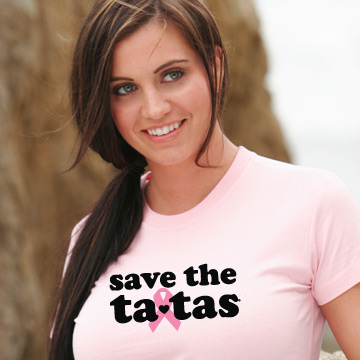
“Save the lymph nodes” just doesn’t have quite the same ring?
I’m not trying to suggest that raising awareness of and funding research for breast cancer isn’t important, but I am interested in the strategies by which being “against” breast cancer is (literally) sold to us. And I’m curious about how this affects treatment and research funding, if at all, and the rationality of our resource distribution given the application of a marketing approach to (some) diseases (and not others). (Also in breast cancer marketing, see here, here, here, here, and here.)
—————————
Lisa Wade is a professor of sociology at Occidental College. You can follow her on Twitter and Facebook.

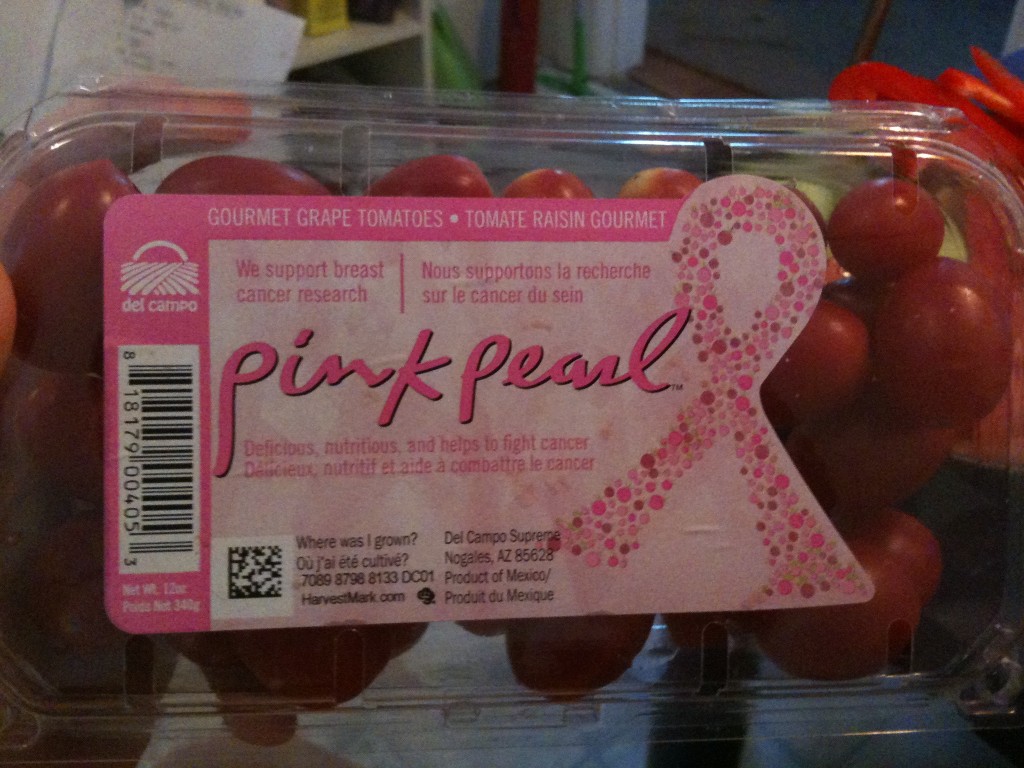
Comments 46
Natalie — May 19, 2009
How big is Movember in other countries? The website says it began in Australia, and it seems increasingly big in New Zealand. Men grow a moustache in November, are sponsered, and the proceeds go to various causes associated with minimising the damage of prostate cancer.
Seeing guys really getting behind this cause is partucularly heartening, for me, given the cliche of "men don't care about their health" (I don't how strongly this is backed up, although I seem to remember it is some). Although to be fair, how much doing this funny thing is correlated to actually going in for their exams when they are older remains to be seen.
mordicai — May 19, 2009
Well first off, "heart disease" is a big umbrella-- kind of a meaningless one. I mean...you get old & your parts stop working-- your heart is a pretty important one, so when it goes, pfft! You do too. I think "heart disease" is seen as "part of getting old."
Breast cancer can happen to half the population, has visible survivors, effects visible body parts, & yeah, has a good campaign. Like AIDS, which has big visibility. Sex sells! Even in disease. Weird world.
blablover5 — May 19, 2009
I wonder sometimes just how much of the money really goes to research and just how much the adding pink to stuff has become a marketing campaign. As companies realize that just making something pink and saying they'll donate some of the money means they bring in more then maybe put that money back to more advertising to breast cancer and research doesn't see a cent.
Dangger — May 19, 2009
It is more or less the same with Fair Trade. They rely on mainstream retailers and use the rhetoric for marketing purposes as well.
Umlud — May 19, 2009
mordicai, technically "cancer" is also a big umbrella that is a description of a symptom, and not a cause. (Similar with the terms "diabetes", "influenza", "AIDS", etc. These are relics of our methods of conducting medical science; naming diseases after symptoms before one was able to investigate causes.) Dismissing heart disease because of this is similar to dismissing breast cancer (a disease symptom possibly with more than one cause), which is obviously not what is happening. But that's a small point.
I think with many diseases, it is possible to blame the victim for the cause, especially if that disease is related to lifestyle choices. Since heart disease and type 2 diabetes occur with greater prevalence in obese individuals, there is an easier option of blaming the disease on the fact that most people who have it are somehow in a condition of their own making.... And tough cookies. Of course, this suffers from misconceptions of what the disease is (i.e., HIV vs. AIDS) or lumping similar diseases together that have different causes (i.e., type 1 and type 2 diabetes).
Echoing modicai's point, though, sex does sell in a lot of cases, and in a culture where breasts are (to some lesser or greater extent) fetishized, "selling" breast cancer is (imho) not too difficult. The prostate, however, is not such a sexual fetish (and not immediately recognizable object), so the idea of "prostate cancer cream cheese" or "prostate cancer cat chow" stretches credulity a little bit.
However, if these non-sex-related cancers became normalized (thanks to a successful positive campaign), then I'm sure that people would would consider purchasing a cancer-X-awareness product.
On a related vein, and going off of what Dangger wrote, an unfortunate possible effect could be socioeconomic disenfranchisement if there is an associated perception for a need of all sectors of society to literally "buy in" to the movement. Should poorer people be expected to also be involved in this drive if it costs more money to do so? Will the perception from that group shift such movements toward an "elitist" direction? This is - to a greater extent - what happened to the environmental movement to such an extent that in many poorer places (whether it be rural or urban), the buy-in to the concept of "environmental" is quite low. One could only hope that such things don't continue happening with public health concerns (in which I personally include environmental protection).
jamy — May 19, 2009
Men can get breast cancer too.
Also, isn't the origin for all this flashy PR the history of women's health being fairly completely ignored and relegated to a subset of "health" in general?
I don't care for the all the pink/gendered packaging, but I supposed it does serve a purpose.
Beth — May 19, 2009
"Also, isn’t the origin for all this flashy PR the history of women’s health being fairly completely ignored and relegated to a subset of “health” in general?"
This. Along with women's health being mostly defined by reproduction and continued attractiveness/sexual availability to men.
Men get breast cancer just like men get HPV, which is to say at a far reduced rate such that it primarily affects women and if you were distributing resources based on prevalence in males it would be way, way down the list. At one point the resources given over to it were at the level you'd expect if you only cared about men's health, and by the time the research money started to be there they had established this massive, commercial infrastructure. If there has been a small over-correction, it is probably still making up for the previous neglect.
Some history:
http://www.healthcentral.com/breast-cancer/c/4535/15438/lesson
http://leahy.senate.gov/press/199209/920930.html
Additionally the visible activists on this issue are almost all women and the consumers who care are probably mostly women. Thus, it is a cheap way for a company to appear strong on women's issues without, say, having to actually promote women into upper management.
stupid me — May 19, 2009
"I think with many diseases, it is possible to blame the victim for the cause, especially if that disease is related to lifestyle choices. Since heart disease and type 2 diabetes occur with greater prevalence in obese individuals, there is an easier option of blaming the disease on the fact that most people who have it are somehow in a condition of their own making"
Ah thanks, Umlud. I had almost gotten over feeling like a shitty person for getting type II diabetes at 20. Thanks for reminding me how it's all my fault; damn me and my attempts at surrounding myself with positive people and mentalities for the past year! I should have realized at 8 that being chubby really is a death sentence. I appreciate being able to be reminded about how little I deserve to live, especially when visiting my favorite blogs. It's a little TOO easy to escape blaming myself! Thanks Umlud! I'll be sure to tell you if I ever get over my depression again. It's good to know there are lovely people out there like you ready to remind me that I'm a stupid fat bitch :)
Sabre — May 19, 2009
Breast cancer does get a disproportionate share of publicity as compared to other cancers and diseases in general. I think that part of the reason for this lies in breasts being over-glorified as sexual commodities and the defining features of attractive womanhood - so as well as the health aspect of say, losing a breast, there's the sexual appeal to consider. This makes breast cancer seem disproportinately more terrible.
Testicular cancer has some parallels in that many men can perceive this to be a threat to their notion of manhood. The difference may be that testicles are less visible and (as mentioned above) less fetishised by Western societies. Men are not taught by our culture that two symmetrical testicles are essential for sex appeal.
Part of the appeal of breast cancer-themed products and activities is that it gives women an excuse to bond or share a common cause. I think men need that less as they have more opportunities for sharing common causes in everyday life.
Chicho — May 19, 2009
What you seem to be missing is that breast cancer is easy to screen for. By raising awareness is not "cancer is bad" is more "check yourself". I wont dwell on how difficult it would be to perform a colon cancer self-examination.
Also, I do admit I felt rather odd playing with a breast-cancer-themed Scrabble.
Will — May 19, 2009
I have a breast cancer USB key. It was the cheapest one at Radio Shack!
mordicai — May 19, 2009
Sure, you're right about "cancer" being a fairly broad heading, but the very buy-in to the article sub-divided cancer...like the fact that it is talking about breast cancer? & compares it to colon cancer, et al? So yeah, I didn't redundantly repeat that by saying it again & repeating it.
Also, I don't know if I want to start the inevitable flame war here, but I have to agree with you somewhat on health care &...well, personal responsibility for your own health. On one hand, people ARE being marketed sodas & cigarettes nonstop; which is messed up, a little. Then again, assuming these things can get you into a lot of trouble; I'd rather positively reinforce healthy lifestyles than tear down people who are already sick. Of course, if it were up to me, soda would cost 7 dollars a can & 6 of it would go to taxes...but that is how I roll.
betenoire — May 19, 2009
To the commenter "stupid me"...
I'm obese and Type II diabetes runs in my family. I'm only 22 but I've already heard my fair share of warnings about developing the disease too. I come from a family of medical professionals and my father is a cardiologist, so their warnings are taken that much more seriously...
I never get angry with these people for telling me this because I know it is true. I could wake up tomorrow with diabetes and have no one to blame but myself. By that same token, I don't see why you are angry with Umlud. No one is saying you don't deserve to live. Don't be melodramatic. But the fact is that your disease is a product of your genes and your lifestyle habits, and therefore *most people* will feel less sympathetic toward your condition than to a person who followed all the rules and still got sick.
John — May 19, 2009
@ stupid me... the comment from Umlud was not saying that fat people are to blame for getting type-2 diabetes, rather I believe that Umlud was saying that people tend to place blame on the people who get it.
Reading Umlud's statement again in the context of the paragraph, it seems to indicate that this is Umlud's personal perception of how others might think of why people might not rally around heart disease or diabetes (but the ADA is making major strides on the fundraising via Race for a Cure).
To put in my two cents viz diabetes, my ex had type-1 diabetes, but because of the increasing prevalence of type-2 diabetes (and the popular perception of the causes of diabetes), she had problems of people assuming that she was to blame for their condition. Of course, type-1 is (afaik) totally genetically based and in general more fatal than type-2 diabetes.
To put in my two shekels viz breast cancer popularity: marketing, marketing, marketing by a major NGO effort. This efforts has tapped into feelings of popular concern, especially (if I remember correctly) since it used to be a death sentence for many women even twenty years ago. Of course, the movement had to overcome the social taboo of talking openly about breasts (I mean, 20 years ago, this was radical). However, it was very successful. I wonder if it was because it tied itself (or was picked up) by many women's groups and organizations as well as major female public figures, especially if they were fighting breast cancer themselves.
stupid me — May 19, 2009
Of course, I was agreeing. I just wanted to let Umlud know that being reminded that my paranoia that people blame me for "doing this to myself" is completely sound was a great thing. I was getting way too happy and I should be glad that someone out there is reminding me that I should go back to being depressed and blaming myself. Why do we even need to blame people for getting sick!? That's something I don't understand. Why should we blame? Shouldn't we just work towards cures and helping everyone, regardless of why they're sick? That's silly imho. But of course, I have vested interests.
Also, I really dislike how you seem to think that *I* shouldn't be upset because if *you* got diabetes you would blame yourself. You know, I sincerely doubt you'd just laugh it off. You would feel like shit and blame yourself and try and get over it, then you would find someone talking about how it's 'totally cool to blame a fat-ass diabetic' and feel like you want to die.
I guess I just wanted Umlud, and now you, to know that you've succeeded in making someone you don't know kinda want to just drop dead, even though I had gotten over those feelings and started working towards a better lifestyle and better health. Anyway, thank you both for reminding me that I TOTALLY asked for this. It really makes me want to stop breathing :) Thanks!
Susanne — May 19, 2009
To everyone going back and forth on blaming the victim for their illness - well... Illnesses of ANY sort don't just happen. It's genetics, it's eating, it's sex, it's walking out into the sunlight, it's avoiding the sunlight - anything can get you sick, give you cancer, give you whatever. It's not common to go about your life striving to get a disease - it just happens by living and attempting to enjoy your life. No one deserves to get sick, but it happens. And what's important is for people to come together and try to solve the problem, right?
imnotemily — May 19, 2009
I have a bright pink breast cancer pepper spray dispenser- how weird is that?
Yonah — May 20, 2009
Would one market prostate cancer awareness with a brown scrunchie?
Esme — May 20, 2009
My senior research was on breast cancer cause related marketing. My analysis found that this type of marketing disappears survivors, hides the realities of the disease behind vague platitudes about "research" and "cure," and infantilizes those with the disease
special — May 20, 2009
you might love this site: thinkbeforeyoupink.org
they look at "pink" products and how much of your money might actually go to the cause. many companies limit how much of the profits end up getting donated - so maybe the first 100 pink lipsticks purchased count and after that, nothing, just marketing. they also point out which ones might be silly, like yogurt lids, because for the cost of the stamp you may be able to make a bigger donation. it's very interesting. they (Breast Cancer Action - who runs the site) also really pushed Yoplait to make their yogurt rBGH free because of a suspected cancer link.
sbg6 — May 20, 2009
Although there are many interesting social factors why breast cancer might get extra attention, there are also valid arguments that the attention is not disproportionate to the damage the disease causes, or at least less disproportionate than it seems. One of the most important reasons is that it strikes younger than other cancers. While many types of cancer typically kill people in their 60s, 70s, and 80s, breast cancer kills younger women typically in their 30s, 40s, and 50s. If you measure how many years of expected life are lost to a disease, rather than the number of deaths, breast cancer is far worse than any other type of cancer (including childhood cancers, which are comparatively quite rare), heart disease, etc.
Ali — May 20, 2009
Not quite. If there was a skinny person and a fat person standing next to each other, both with type II diabetes, *most people* will feel less sympathetic towards the fat person, even if he/she "followed all the rules" and the skinny person ate nothing but junk food and sat on their ass all day.
Stupid me, just in case you don't already frequent there, definitely start reading kateharding.net
Ali — May 20, 2009
Also, I definitely agree with Esme. If I ever had the misfortune of getting breast cancer myself I would wear a shirt that said "Fuck the ta-tas, save ME!"
Duran — May 20, 2009
The disprorportionate attention paid to breast cancer is NOT at all about breasts being an object of sexual curiosity.
It's, essentially, about girl power. One outgrowth of the feminist movement has been this focus on a particularly female disease (yes, I realize men can get breast cancer too).
It's actually a really good thing. I wish men could do the same thing about prostate cancer.
Can you imagine a prostate cancer "Walk for the Cure"?
Go chicks!!
pffft — May 20, 2009
What we have here is a lot of companies making their products pink in an attempt to persuade people to buy them--some of them are making more and less donations to breast cancer related organizations. How is that about girl power?
It's about trying to appeal to the public and their wallets. Seriously, read that link special posted. A lot of these same companies are selling products that just put more people at risk. They wouldn't do this if it even put them at a slight risk of financial loss.
I don't see this trend as being particularly different from the Della debacle. Just another instance of pink being used to try to separate me from my cash.
I think this has been as successful as it has because...
A) nobody likes talking/thinking about "the big C" and this puts a more pleasant, upbeat idea in mind--like esme said
B) it's one of the most visually recognizable ribbons
C) this gives people a chance to see themselves as conscientious--many will not turn it down simply because they see their consumer choices as self-defining
Anonymous — May 20, 2009
Marketers donate some small fraction of their profits to breast cancer and slap pink labels on their products because it is a really easy way to reach the female demographic they're targeting. These labels communicate to potential female customers that the company "has a heart" and cares specifically about women; in short, they engender in women good feelings about the brand. And don't women do the majority of household shopping?
I think breast cancer awareness has become much more popular because breasts are such a visible body part (as opposed to the pancreas), and because they are such a sexualized body part.
I have to admit that, to a certain extent, I find this type of marketing annoying. Maybe because I am realistic about the companies' motives in engaging in such marketing. Maybe its because I dislike the use of the color pink to signify all things female (as if somehow women inherently had a prediliction towards one color), especially since its infantilizing, as pink is mostly associated with little girls. Maybe its because, as a women who is nearly flat chested, I am insulted by the idea that breasts are a definitive component of adult feminitity, that not having them somehow makes a person less of a women, and that life as a female without noticable breasts is somehow unlivable.
...but as long as this type of marketing ends up helping people, I can definitely deal with it.
Ashley — May 20, 2009
Coming from an organization that has tried to get funding from corporations that market to women, but has been rejected because of our radical politics (for example, Liz Claiborne rejected our proposal because they were afraid of what might happen when college students organized around sexual violence--they didn't want protests associated with their funding), I think I'd say that doing something for breast cancer awareness is a way for a company to do something good for women and get good PR with their target demographic, without doing anything feminist, or anything that threatens the status quo. Nearly any other nonprofit organizations working on behalf of women are in some way challenging patriarchy, but breast cancer awareness does not.
Dubi — May 20, 2009
I wonder - does money really go specifically to breast cancer research? That is, can they look for cures specifically for breast cancer, or are they simply researching "cancer" in general, in which case advertising donations for breast cancer research would make breasts kinda like pandas - the cute and lovable things people are willing to donate to save when in fact the scientists are more into saving the many plants and insects that live in the same habitat.
Bagelsan — May 21, 2009
Stupid me: I understand that you're upset (even though I *don't* think that anyone was suggesting that overweight people *should* be blamed for their illnesses, just that they often are) but seriously, stop using depression and suicidal thoughts as a conversational bludgeon. They're a serious problem that millions of people have to deal with every day, not a way for you to win a (straw man) argument on a blog.
Bagelsan — May 21, 2009
I wonder - does money really go specifically to breast cancer research? That is, can they look for cures specifically for breast cancer, or are they simply researching “cancer” in general
I don't know about the funding, but as for the research side of things it is possible to research either cancer in general or breast cancer specifically. Or you can research breast cancer in particular in order to also find out more about cancer in general (or you can apply research on cancer in general to breast cancer specifically, too. Yay reciprocity.) But yeah, there is definitely research that is pretty breast cancer specific (like looking at BRCA, etc.) though I don't know how funding from the campaign is divided up.
Kelle — May 21, 2009
Just a note, Type I diabetes is an autoimmune disease. The genetics of it are actually fairly sketchy.
Type II diabetes is strongly genetic and heritable. Nobody actually knows for sure what causes type 2, and claiming it's caused by obesity, eating sugar, not exercising, etc, is simply wrong. It's believed there's a "genetic strain" in which people are both fat and develop type 2 diabetes. Type 2 is very much a disease of ageing and one of the interesting theories researchers have found is that it's extreme stress that can trigger it - stress basically wearing your body out faster than otherwise. Ignoring this fact in favor of OMG OBESITY = DIABEETUS does no one with type 2 diabetes any favours as it directs research in entirely the wrong direction. Losing weight may put type 2 diabetes into remission, but as the body adapts to lower weight or weight is regained, it often comes back.
As for breast cancer fundraising - read thinkbeforeyoupink.org for a lot of interesting thoughts on the pink campaign.
Tracy — May 21, 2009
My so glad someone else feels the same way as I do on the insane amount of breast cancer awareness merchandise available. I found some pink ribbon tissues and I stated "Now I can sneeze for a cure!"
You asked the question in your post: "Why does breast cancer get so much attention?" Honestly, I think it has to do with the fact that women spend money, and breast cancer is by and large a woman's cancer so therefore they can get woman to spend money.
It's all about money.
I've know women who will buy a product only due to the fact that it has a pink ribbon on it. And what's sad is that some companies slap a pink ribbon on a product but may never donate a cent to any research groups.
Jessica — May 21, 2009
I agree with many of the other posters above when they said that in a society obsessed with women's breasts, it seems pretty predictable that would transfer over to being obsessed with diseases involving those same breasts.
pg — May 22, 2009
I want a T-shirt that says "Save the 'nads!"
or, "'Nads are Rad!"
sara — May 22, 2009
I'm pretty sure the national obsession with breast cancer is a direct reaction to the fact that it used to be a taboo disease to discuss, and so women mobilized around it to make it visible and audible. And that spiralled.
Victoria — May 23, 2009
This was just posted on PostSecret and reminded me specifically of this post on Sociological Images:
http://3.bp.blogspot.com/_a7jkcMVp5Vg/ShiC1gGq_jI/AAAAAAAAI8Y/hbU_II3kgvE/s1600-h/pink.jpg
Interesting gender stuff going on here.
Sociological Images » What We’ve Been Up To Behind Your Back (June 2009) — July 1, 2009
[...] Also in boobs,we added another example of breast cancer marketing, this time a breast cancer-themed limousine sent in by Steve W., to our post on the topic. [...]
Boobies Against Breast Cancer » Sociological Images — October 12, 2009
[...] the amount of money people donate directly because they think that by buying the breast cancer cookies, cream cheese, combination locks, cat food, cookware, chewing gum, limo rides, and golf acce..., they’ve already done their [...]
Pink. » Sociological Images — November 26, 2009
[...] Pink. Pink. Pink. Pink. Pink. Pink. Pink. Pink. Pink. Pink. Pink. Pink. Pink. Pink. Pink. Pink. Pink. [...]
Is “Save the Ta-tas” the New Feminism? I Hope Not. « of Heart and Mind — January 4, 2010
[...] is great. But you don’t see them fighting for gender parity in sports reporting. Similarly, a myriad of corporations has taken up the cause of breast cancer in order to sell products (and supposedly raise money). [...]
Intergalactic human of mystery — June 1, 2010
I have some breast cancer themed bird food, which I always thought was odd.
Breast Cancer Awareness Marketing has a Pink Problem | Scientopia Guests' Blog — August 14, 2011
[...] Lindsey B. alerted us to a newly published paper in the Journal of Marketing Research suggesting that the current approach to raising awareness of breast cancer hurts more than helps. You might have noticed, just maybe, I mean if you’ve been paying attention, that breast cancer has become associated with the color pink. [...]
Disease marketing? Sempre più pervasivo | .commEurope — April 14, 2012
[...] simil-medici supportano le campagne di marketing di prodotti e servizi. In ogni supermercato compaiono decine di prodotti che dichiarano di supportare a campagne di lotta contro malattie note oppure fanno leva sulle [...]
mamsi.no / Victoria Ibabao Edwards | Rosa sløyfe-galskap og shoppingbonanza — October 7, 2014
[…] her, for eksempel. Alle disse bildene er hentet fra denne artikkelen på Sociological images. Det er flere bilder der, så klikk deg inn der for å se […]
Breast Cancer Awareness Marketing has a Pink Problem | Scientopia's Guest Blog — July 27, 2015
[…] Lindsey B. alerted us to a newly published paper in the Journal of Marketing Research suggesting that the current approach to raising awareness of breast cancer hurts more than helps. You might have noticed, just maybe, I mean if you’ve been paying attention, that breast cancer has become associated with the color pink. […]
Big Rock Pub — October 13, 2015
[…] Should Marketing Principles Be Applied to Disease […]